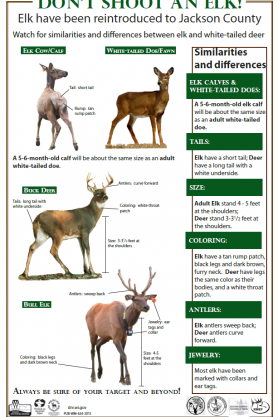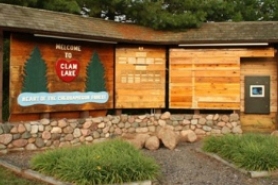ELK IN WISCONSIN
BE A PART OF DEVELOPING THE NEW WISCONSIN ELK PLAN
The department has recently completed the Draft 2020-2030 Elk Management Plan. For more information on the plan development process you can:
- Review a presentation that summarizes elk management in Wisconsin and the Draft 2020-2030 Elk management Plan;
- Register to attend an online open house meeting:
- Meetings to be held January 9 (10-12am) and January 11 (6-8pm).
- Please note: These meetings will be informational only. Official comments can be submitted using the options below.
The department is also accepting public input on the plan. Comments can be sent either to elkplan@wisconsin.gov or directly to:
Scott Roepke, 910 Highway 54E, Black River Falls, WI 54615
Comments need to be received or postmarked by January 23, 2021.
Once widespread here and across North America, elk were eliminated from Wisconsin in the 1880s due to unregulated hunting and habitat loss. Over 130 years later, they once again live in the central and northern forest regions of our state. From a population of 25 elk reintroduced in 1995, and with the help of the second reintroduction efforts that started in 2015, the state’s total elk population is quickly approaching 400 animals.
Thanks to the support of multiple partners and the backing of Wisconsin citizens, the bugle of rutting September bulls is back and here to stay!
POPULATIONS AND MANAGEMENT
- Elk are found in two distinct ranges in Wisconsin. The largest, and oldest, elk herd in the state is the Clam Lake elk herd. The Clam Lake herd ranges across Ashland, Bayfield, Price, Sawyer and Rusk counties in northern Wisconsin. The other, the Black River elk herd, is found in the forested region of Jackson County in the central part of the state. Reports on each herd can be found below.
Current management practices are aimed at securing the future of elk in Wisconsin. Ongoing research is being utilized to gain additional knowledge regarding survival and recruitment rates, habitat use and movement patterns. The first state-managed hunt for elk in Wisconsin was held in 2018 in the Clam Lake Elk Range only. Visit the Elk Hunting page for more information.
-
CLAM LAKE HERD
- Exciting rutting activity by a Clam Lake bull.
The Clam Lake elk herd was estimated to be approximately 190 individuals as of March 2019. With the addition of new animals through natural reproduction within the herd and the translocation of elk from Kentucky in the spring of 2019, the herd is expected to exceed 250 individuals by autumn of 2019. This population has grown slowly, but steadily since reintroduction in 1995. Wisconsin will again hold a very limited hunt in the Clam Lake Elk Range this fall.
January-December 2019 Clam Lake elk herd update [PDF]
Although they currently occupy approximately 90 square miles of the designated elk range, the herd has grown at an average rate of 13% annually. However, growth rates have varied from as high as 30% to as low as -16% since 1995. Primary causes of mortality include predation by wolves and black bears and vehicle collisions. Primary habitat used by the elk consists of aspen and pine forests interspersed with forest openings, lowland conifers and water bodies.
Clam Lake elk range
Based on the habitat suitability model derived from a study by Didier and Porter, the Wisconsin Elk Study Committee (WESCO) determined that the United States Forest Service (USFS) Great Divide District (GDD) of the Chequamegon National Forest (CNF) near Clam Lake was most suited for an elk reintroduction.
The Clam Lake elk range was recently expanded by 506 square miles so the CNF-GDD currently consists of 1,221 sq miles (781,440 acres) in portions of Ashland, Bayfield, Price, Rusk and Sawyer counties in north-central Wisconsin. State Highway 77 and county highways GG and M converge near the center of the GDD at the community of Clam Lake. The GDD is mostly under National Forest ownership (81% or 370,656 acres). The remaining 19% (86,944 acres) is privately owned, with relatively little in agricultural production.
-
BLACK RIVER HERD
- The Black River elk herd was estimated to contain approximately 60 animals as of March 2019. With approximately 20 calves expected to be born this spring, the herd is projected to approach 75-80 individuals by late 2019. Calf survival has been very high, with 17 confirmed births in 2018, and all 17 calves still alive as of March 2019. Vehicle collisions are the leading cause of mortality in the Black River herd, and no elk have been killed by predation since September of 2016. After the initial expected drop in numbers following reintroduction, the population is beginning to climb and the Black River herd is showing good signs of population increase.
January-December 2019 Black River elk herd update[PDF]
An important message about elk viewing in Jackson County
To ensure the successful reintroduction of elk into Jackson County, please respect the elk and their habitat. Disturbances to the elk, such as calling them or attempting to view them by foot, may force the elk into areas in which they may not otherwise reside and can make them more susceptible to predation, vehicle collisions, or other undesirable circumstances.
While it is understandable that people will have the desire to observe the elk, in the interest of the animals’ health the public is asked to refrain from pressuring or calling to the elk during the rutting season. This type of disturbance can disrupt breeding activities and separate the elk from their family units, leading to slower population growth.
The many partners involved in the elk reintroduction are happy to see high public interest and excitement surrounding the elk reintroduction. Please respect the elk’s space and view them from afar.
- Black River elk range
In December of 2001, the Natural Resources Board (NRB) approved the Black River Elk Herd (BREH) Management Plan. The Black River Elk Range (BRER) is approximately 320 sq. miles and located in the Central Forest region of eastern Jackson County.
-
CHRONIC WASTING DISEASE
Chronic wasting disease (CWD) is a degenerative disease of the brain and nervous system tissue that infects members of the cervid family (deer, elk, etc.). CWD is present in white-tailed deer in Wisconsin but has not yet been detected in an elk in Wisconsin. All hunter-harvested elk, and all elk that die of other causes that a viable sample can be taken from, are tested for CWD.
HEALTH MONITORING OF TRANSLOCATED ELK
In evaluating and establishing a testing protocol for disease testing and the overall health of elk moved from Kentucky to Wisconsin, the DNR worked with our sister state agency, the Department of Agriculture, Trade, and Consumer Protection (DATCP), and the United States Department of Agriculture, Cervid Health program (USDA) to establish the necessary transport and importation testing that was required by these agencies.
We also considered additional diseases that may be of concern to both wildlife and domestic animals within the state. The outcome was a testing protocol that required the elk being translocated be held in quarantine for a minimum of 120 days while multiple rounds of whole herd testing occurred. Each year, the testing protocol was evaluated by these agencies, including the results of previous years’ tests and any necropsies (the animal equivalent to an autopsy) of translocated elk.
Mandatory testing included tests for bovine tuberculosis and Brucella abortus, as well as an extensive risk assessment that evaluated the possibility of chronic wasting disease in the region of Kentucky where elk were being translocated from. In addition, the DNR tested for diseases that primarily affect wildlife or, in some cases, primarily affect domestic animals and can spill over into wildlife, including bovine viral diarrhea virus, bluetongue, epizootic hemorrhagic disease as well as a complete blood count with an evaluation of both the red and white blood cells.
Prior to translocation, the elk were also treated with anthelmintics to reduce external and internal parasite loads as much as biologically possible.
2019 translocation documents
- 2019 elk translocation summary [PDF]
- Kentucky/Wisconsin Interstate Movement of Wild Cervids signed agreement [PDF]
- Kentucky and CWD
- CWD Sampling in Kentucky 2002-2017 [PDF]
- 2016 Kentucky CWD Cervid Risk Assessment [PDF]
- 2016-2017 Kentucky CWD Sampling Map [PDF]
- 2017 Kentucky CWD Cervid Risk Assessment [PDF]
- 2017-2018 Kentucky CWD Sampling Map [PDF]
-
ELK ADVISORY COMMITTEE
- The Elk Advisory Committee reviews and makes recommendations on the reintroduction and management of wild elk. The committee advises the Wildlife Policy Team on a variety of topics such as herd monitoring and growth strategies, research priorities, herd health issues and other reintroduction strategies. The committee will provide input on other elk herd management and policy decisions as requested.
Committee meeting minutes
ONGOING PROJECTS
-
Click to enlarge Department staff members are tending to numerous projects to ensure the success and sustainability of our Wisconsin elk herds. Some recent and ongoing projects include:
- surveyed citizens on their awareness and views of elk and their management in Wisconsin [PDF]. Results showed that, in general, the public had very positive attitudes towards elk and support their management within the state;
- posting elk management area signs prior to the deer hunting season to ensure that hunters are aware of elk in the area;
- distributing elk identification sheets [PDF] to local registration stations and popular establishments to educate hunters prior to deer hunting season;
- retrieving trail cameras that were deployed and looking at captured photos in order to obtain a bull population estimate and assess calf production and survivorship;
- completing habitat work for elk including creating two large wildlife openings in the Flambeau River State Forest that are planted with winter wheat and rye — they will be replanted with clover and timothy next spring or early summer;
- working on an assisted dispersal of Clam Lake elk to ensure that the entire Clam Lake elk range is utilized; and
- obtaining weekly locations on all currently collared elk including males, females and calves as well as doing a weekly mortality check.
-
VIEWING CLAM LAKE ELK
-
An interactive touch screen kiosk has been retrofitted into an existing signboard located at the junction of state highways 77 and GG in Clam Lake. The kiosk is designed to provide visitors to the area with expansive information about the resident elk herd and their habitat.
The program provides information about the history of elk in Wisconsin and even has a video clip of the original elk reintroduction. Most importantly, the program contains other tools and information to help visitors experience elk including wildlife spotting guides, maps and directions to nearby viewing areas.
Please note that the interactive kiosk may not be available during winter months.
Tips [PDF] for viewing elk near Clam Lake




